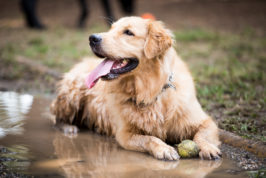The guide to Arthritis in dogs
Arthritis, also known as Osteoarthritis, or OA, is an extremely common and painful condition that’s estimated to affect one in five dogs over the age of one. In this guide, Dr Joanna Woodnutt explains what Osteoarthritis is, what causes it, and how you can help a dog with arthritis feel more comfortable…
The healthy canine joint
Where any two bones in your dog’s body meet, they form a joint. This joint is composed of several important parts:
- The articular cartilage – a thin cartilage layer that covers the end of each bone, acting as a cushion and a smooth gliding surface to reduce friction.
- The joint capsule, which surrounds the joint to make a seal and provides joint stability.
- The joint fluid or synovial fluid – a lubricant with the consistency of egg whites. It’s secreted into the joint from the capsule and reduces the friction of the moving joint.
Between the synovial fluid and the healthy cartilage, a normal joint has very little friction and is resistant to wear and tear.
Arthritic changes in canine joints
Osteoarthritis is a common degenerative disease that causes painful inflammation and permanent damage to the joints. A dog suffering from Osteoarthritis will experience the following:
- The articular cartilage becomes thinner, worn and pitted. Pieces may break off and float around in the joint.
- The joint capsule becomes inflamed. Initially, this may be felt as heat or swelling, but over time it can become toughened and stiff.
- The synovial fluid changes in consistency, becoming thinner and less lubricating.
With all these changes, the smooth sliding motion of the joint is lost. Every time your dog moves his or her joints, the cartilage grinds together, causing inflammation. It’s a vicious cycle, as some inflammatory compounds further damage the joint. The cartilage can become so worn that the bone underneath becomes damaged.
What causes Canine Arthritis?
We know that there are lots of possible causes of Arthritis in dogs, and each dog is likely to have several contributing factors. Some of the common causes include:
Hip Dysplasia and other developmental diseases
Dogs with malformed joints (dysplasia) are more likely to get Arthritis in those joints. Any joint can be affected by dysplasia, but the common joints are hips, elbows and shoulders.
Trauma and injury
Trauma to the joint can cause inflammation, which damages the cartilage surface. Injuries that make Arthritis more likely include a break (fracture), a joint condition (such as Patella Luxation or Cruciate Ligament Disease), or even a severe knock, such as landing from a height.
Obesity
Overweight dogs are significantly more likely to suffer with Arthritis and associated chronic pain. Not only are these dogs putting extra weight through their joints with each step, but excess fat causes the release of inflammatory messages, increasing inflammation and pain in the body. With 51% of dogs thought to be overweight or obese, excess weight is one of the key causes of Arthritis in dogs.
Some types of exercise
Exercise and Arthritis are a complicated combination. We know that not all exercise increases the risk of Arthritis, but that some types, like chasing after a ball, do. Young puppies climbing stairs and playing with other dogs have also been associated with an increased risk.
What are the signs of Arthritis in dogs?

One of the difficulties Arthritis presents is that it can be subtle. Many pet parents think their dog is simply ‘getting old’, or ‘slowing down in his or her old age’. Because dogs don’t cry out in pain, many people struggle to recognise that their dog might be suffering with Arthritis. The signs of Arthritis in dogs include:
- Stiffness, especially after rest
- Difficulty in getting up or down
- Reluctance to walk as far, or exercise normally
- Reluctance to use the stairs, or jump onto the sofa
- Lameness, which may be on/off and subtle
- Change in posture, walking stiffly
- Licking sore joints
- Reluctance to join in games and play
- Sleeping more than usual
- Aggression and other changes in behaviour
- Weight changes, or muscle loss (especially noticeable on the thighs)
It’s especially important to remember that Arthritis can affect dogs of all ages, especially if they have dysplasia or a previous injury. If you’re seeing these signs in your dog, no matter their age, you should book an appointment with your veterinary team.
Treatments for Arthritis in dogs

There is no ‘cure’ for Arthritis. It’s a degenerative disease, which means it gets worse over time. That said, the progression of the disease may be able to be slowed, and symptoms can be relieved using a variety of methods…
Joint supplements
Joint supplements provide nutrients that the joints can use to repair themselves. They may include the building blocks of cartilage (like Chondroitin), natural anti-inflammatories such as Omega-3, and Hyaluronic Acid to improve synovial fluid quality.
Joint supplements are a great tool for managing Arthritis, but may not provide sufficient pain relief on their own. They can also take several weeks to take effect, so your dog may need other medications in the meantime.
Joint supplements are best used as part of a treatment plan, and may also be used preventatively in dogs at risk of joint disease.
Medication
Your vet can prescribe pain relief to your dog. This might come in the form of Non-Steroidal Anti-Inflammatory Drugs (NSAIDS), or other pain-relieving drugs, such as Gabapentin. Your dog may need to stay on these for life, which means regular blood tests to monitor for side effects.
Diet and exercise
Dogs that are overweight should be encouraged to lose weight. While this is difficult in a dog that’s reluctant to exercise, your vet can advise on reducing their daily calorie intake.
Dogs should still exercise in order to keep joints limber and to prevent muscle wastage. Walks tend to be slower, and you may need to change where you walk to make it easier for your dog. Shorter, more frequent walks are better for your dog, and help to prevent the joints from stiffening up. You can read more about exercising your arthritic dog here.
Hydrotherapy is a great way to exercise your dog without putting extra strain on their joints. Even if your dog isn’t keen on water, it’s worth a try – underwater treadmills mean your dog is never out of their depth, and many dogs enjoy it! Ask your vet to recommend a canine hydrotherapist nearby.
Complementary therapies
Acupuncture appears to work well for dogs with Arthritis, and has some evidence backing it up. It can only be undertaken by a registered vet in the UK. Laser therapy is also growing in popularity, and there’s evidence it can help with chronic pain.
There are lots of other complementary therapies advertised for treatment of Arthritis, and some have evidence for them while others don’t. It’s best to talk to your vet before trying any of these methods. Be aware that many of these practitioners don’t have a ‘protected title’, which means anybody can claim to practice these types of medicine, even with little or no training.
Home modifications
There are some important modifications you can make to your home to make it joint friendly. You should consider:
- Ramps for the stairs and car
- Stairgates to restrict unsupervised access to the stairs
- Dog beds that are extra-cushioned and allow your dog to stretch fully
- Rubber-backed, non-slip mats on hard floors
New technologies
Right at the cutting edge of Arthritis treatment are methods like stem cell therapy and platelet rich plasma (PRP) Therapy. These are still in their infancy, and not available to most vets, but there may be an orthopaedic specialist you can discuss these with.
Conclusion
Osteoarthritis is a painful disease that affects many of our dogs for a significant proportion of their lifetime. Unfortunately, it can be difficult to spot, so be alert for the signs in your dog. While Arthritis has no cure, there are many methods of managing the symptoms and making life easier for your dog. Your veterinary team is the best port of call if you’re worried about Arthritis in your dog – they’ll be happy to help!




